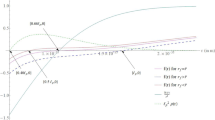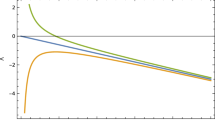Abstract
Using a hyperbolic complex plane, we study the realization of the underlying hyperbolic symmetry as an internal symmetry that enables the unification of scalar fields of cosmological and particle physics interest. Such an unification is achieved along the universal prescriptions used in physics, avoiding the use of concepts such as Euclideanization, non-canonical Lagrangians, and hidden structures that have appeared in other approaches. The scalar potentials constructed within the present scheme are bounded from below, and the realization of the spontaneous symmetry breaking of the aforementioned non-compact symmetry is studied. The profiles of these potentials with exact/broken hyperbolic symmetry replicate qualitative aspects of those ones used in inflationary models, and then, a detailed comparison is made. Moreover, the homotopy constraints of the topology induced on the corresponding vacuum manifolds restrict the existence of topological defects associated with continuous symmetries, allowing only those defects associated with discrete symmetries; the consistency of these results is contrasted with current observational tests from the LIGO/Virgo collaboration and terrestrial experiments based on a synchronized network of atomic magnetometers. At the end, the non-relativistic limit of the model is identified with a hyperbolic version of the nonlinear Schrödinger equation.



Similar content being viewed by others
Notes
In fact, one should expect that both fields \(\phi \) and \(\phi ^{*}\)are consistently transformed.
Generalized commutative rings allow us to define objects that are invariant under both circular and hyperbolic rotations; see Concluding remarks.
A.H.-A. thanks Gabriel Germán for useful discussions on this issue.
Hybrid inflationary models encompass properties of chaotic inflation with \(V(\phi )=\frac{m^2\phi ^2}{2}\) and the usual theory with a spontaneous symmetry breaking mechanism described by the potential \(V(\sigma )=\frac{1}{4\lambda }\left( M^2-\lambda \sigma ^2\right) \).
References
H.F.M. Goner, On the history of unified field theories. Living Rev. Relativ. 7, 2 (2004)
H.F.M. Goner, On the history of unified field theories. Living Rev. Rel. 17, 5 (2014)
R. Cartas-Fuentevilla, O. Meza-Aldama, Spontaneous symmetry breaking, and strings defects in hypercomplex gauge theories. Eur. Phys. J. C 76(2), 98 (2016)
R. Cartas-Fuentevilla, A.J.C. Juarez-Dominguez, Quantum field theory of a hyper-complex scalar field on a commutative ring. arXiv:1705.07981 (2017)
V.V. Kassandrov, Biquaternion electrodynamics and Weyl–Cartan geometry of space-time. Grav. Cosmol. 1, 216 (1995)
V.V. Kassandrov, Algebrodynamics in complex space-time and the complex-quaternionic origin of Minkowski geometry. Grav. Cosmol. 11, 354 (2005)
V.V. Kassandrov, J.A. Rizcallah, Maxwell, Yang-Mills, Weyl and eikonal fields defined by any null shear-free congruence. Int. J. Geom. Methods Mod. Phys. 14(02), 1750031 (2016)
V.V. Asadov, O.V. Kechkin, Quantum theory with arrow of time: symmetry breaking and non-local spinor realization with non-commuting operators of energy and decay. J. Phys. Conf. Ser. 380, 012011 (2012)
D.H. Lyth, A. Riotto, Particle models of inflation and the cosmological density perturbations. Phys. Rep. 314, 1 (1999)
A. Perez-Lorenzana, M. Montesinos, T. Matos, Unification of cosmological scalar fields. Phys. Rev. D 77, 063507 (2008)
D. Fermi, M. Gengo, L. Pizzocchero, On the necessity of phantom fields for solving the horizon problem in scalar cosmologies. Universe 5(3), 76 (2019)
J.M. Cline, S. Jeon, G.D. Moore, The phantom menaced: constraints on low energy-effective ghosts. Phys. Rev. D 70, 043543 (2004)
S. Nojiri, S.D. Odintsov, Quantum de Sitter cosmology and phantom matter. Phys. Lett. B 562, 147 (2003)
V.V. Kisil, Starting with the group \(SL_2(R) \). Not. AMS 54, 1458 (2007)
S. Ulrych, Considerations on the hyperbolic complex Klein–Gordon equation. J. Math. Phys. 51, 063510 (2010)
M. Dine, Problems of naturalness: some lessons from string theory. arXiv:hep-th/9207045
B. Rai, G. Senjanovic, Gravity and the domain wall problem. Phys. Rev. D 49, 2729 (1994)
R.D. Poodiack, K.J. LeClair, Theorems of algebra for the perplexes. Coll. Math. J. 40(5), 322–335 (2009)
S. Ulrych, Relativistic quantum physics with hyperbolic numbers. Phys. Lett. B 625, 313 (2005). [arXiv:hep-th/9904170]
R. Penrose, The Road to Reality, Chapter 28.9 (J. Cape, London, 2004)
J.F. Dufaux, G. Felder, L. Kofman, O. Navros, Gravity waves from tachyonic preheating after hybrid inflation. J. Cosmol. Astropart. Phys. 03, 001 (2009)
M. Pospelov, S. Pustelny, M.P. Ledbetter, D.F. JacksonKimball, W. Gawlik, D. Budker, Detecting domain walls of axionlike models using terrestrial experiments. Phys. Rev. Lett. 110, 021803 (2013)
LIGO Scientific Collaboration, Virgo Collaboration, Constraints on cosmic strings from the LIGO-Virgo gravitational-wave detectors. Phys. Rev. Lett. 112, 131101 (2014)
W. Greiner, J. Reinhardt, Field Quantization (Springer, Berlin, 1996)
J. Kocik, Int. J. Theor. Phys. 38, 8 (1999)
A. Linde, Hybrid inflation. Phys. Rev. D 49, 748 (1994)
M.E. Laycock, P. Millington, Energy-parity from bicomplex algebra. arXiv:1801.08068 (2018)
Acknowledgements
This work was supported by the Sistema Nacional de Investigadores (SNI, Mexico) and the Vicerrectoría de Investigación y Estudios de Posgrado (VIEP-BUAP). Graphics have been made using Mathematica.
Author information
Authors and Affiliations
Corresponding author
Rights and permissions
About this article
Cite this article
Cartas-Fuentevilla, R., Escalante-Hernandez, A., Herrera-Aguilar, A. et al. Hyperbolic symmetries, inflaton–phantom cosmology, and inflation. Eur. Phys. J. Plus 135, 529 (2020). https://doi.org/10.1140/epjp/s13360-020-00513-6
Received:
Accepted:
Published:
DOI: https://doi.org/10.1140/epjp/s13360-020-00513-6




